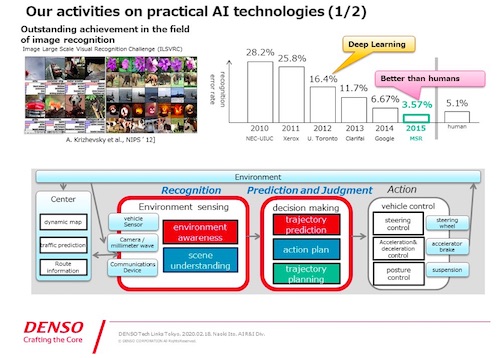To Achieve AI-based Fully Automated Driving: R D Project on Elemental Technologies at DENSO
- Written by ACN Newswire - Press Releases

|
|
Speakers
Naoki Ito General Manager of the Applied AI R&I Dept., AI R&I Div., Advanced Research and Innovation Center
Four Automated Driving Levels and Future Mission
Naoki Ito: I will talk about DENSO's initiatives in automated driving from the viewpoint of R&D on AI.
The theme of my presentation is DENSO's initiatives on advanced driver assistance systems (ADAS) and automated driving (AD) systems. These will become a global trend in the future.
The vertical axis shows the target vehicles, including passenger cars or so-called "privately owned vehicles," commercial vehicles such as trucks, and shared and service cars including taxis and small buses. The horizontal axis shows the AD/ADAS levels. The level increases from left to right.
Automated driving is categorized into four levels (Level 1 to 4). Active safety, which is shown on the left, and about half of ADAS/AD functions fall under Level 1 or 2. On Level 1 and 2, the driver is basically responsible for driving, and the system supports the driver. On Level 3 and Level 4, the system performs the driving task. On Level 3, the driver must take over driving when the system cannot handle it.
On Level 4, the fully automated driving system achieves the driverless driving of small vehicles. Automated valet parking will also be required, though this may fall outside the definition of automated driving.
At present, Level 1 and Level 2 active safety technologies, including collision avoidance braking, adaptive cruise control (ACC), and lane keep assist (LKA) on expressways, are spreading.
Level 2 and Level 3 technologies will need to be developed for arterial and general public roads and Level 4 technologies for service cars in operational design domains (ODDs). Our department serves as an R&D team, so our mission is to develop elemental technologies for Level 3 and Level 4 and contribute to the company's business.
Current Issues in Automated Driving
In research on automated driving, we must address various difficult issues. For example, the sensing performance must be maintained to cope with the backlight at the exit of a tunnel, as well as very poor weather conditions such as heavy rain and dense fog.
Even if the sensing performance is maintained, objects must be detected by the system. Ordinary traffic participants include vehicles, pedestrians, and bicycles. Sometimes there may be unfamiliar objects on the road, and they must be detected. Collision with animals that may enter the road must also be avoided. If a road which was open yesterday is under construction today, it is necessary to make a detour. There are many difficult situations to cope with.
Human drivers can correctly understand the situation based on appropriate judgment, but this is a very difficult problem for fully automated driving.
As I explained, automated driving systems are expected to evolve gradually from simple systems to more complicated systems. Applications will spread from expressways, where it is relatively easy to achieve automated driving, to arterial and general public roads.
There are various challenging issues from the viewpoint of R&D, so this is an exciting field of research.
What Can Be Achieved by Using AI
AI is one solution to address these challenging issues. Here, AI refers to deep learning and machine learning technologies. We have been working to apply AI technologies to vehicles.
You may be familiar with the above figure. Image recognition technologies undergo benchmarking each year. The lower the point on the graph, the higher the accuracy. The recognition accuracy used to be improved only by a few percentage points annually, but deep learning technology, which is one type of AI technology, improved the accuracy by nearly 10%. Deep learning and machine learning technologies have attracted much public attention and many researchers.
Today, the accuracy of image recognition, which is one of the specific tasks, is higher than that of recognition by humans.
We have been working to apply deep learning and machine learning technologies to ADAS/AD.
The figure below is a simple block diagram for automated driving. Information obtained from various sensors of a vehicle is used to recognize the surrounding environment and understand the scene. The recognition block outputs the results of the recognition of objects, and the trajectory of objects can then be predicted. The vehicle behavior and trajectories are measured by using the prediction results to ensure proper control of the steering, braking, and acceleration.
We are attempting to use deep learning and other AI technologies to predict trajectories and plan paths, in addition to recognition.
For the full press release, visit https://bit.ly/32EqVcF.
About Denso
DENSO is a $48.3 billion global mobility supplier that develops advanced technology and components for nearly every vehicle make and model on the road today. With manufacturing at its core, DENSO invests in its 221 facilities in 35 countries to produce thermal, powertrain, mobility, electrification, & electronic systems, to create jobs that directly change how the world moves. The company's 170,000+ employees are paving the way to a mobility future that improves lives, eliminates traffic accidents, and preserves the environment. Globally headquartered in Kariya, Japan, DENSO spent 9.3% of its global consolidated sales on research and development in the fiscal year ending March 31, 2019. For more information about global DENSO, visit https://www.denso.com/global.
Copyright 2020 JCN Newswire. All rights reserved. www.jcnnewswire.com
Authors: ACN Newswire - Press Releases
Read more //?#


